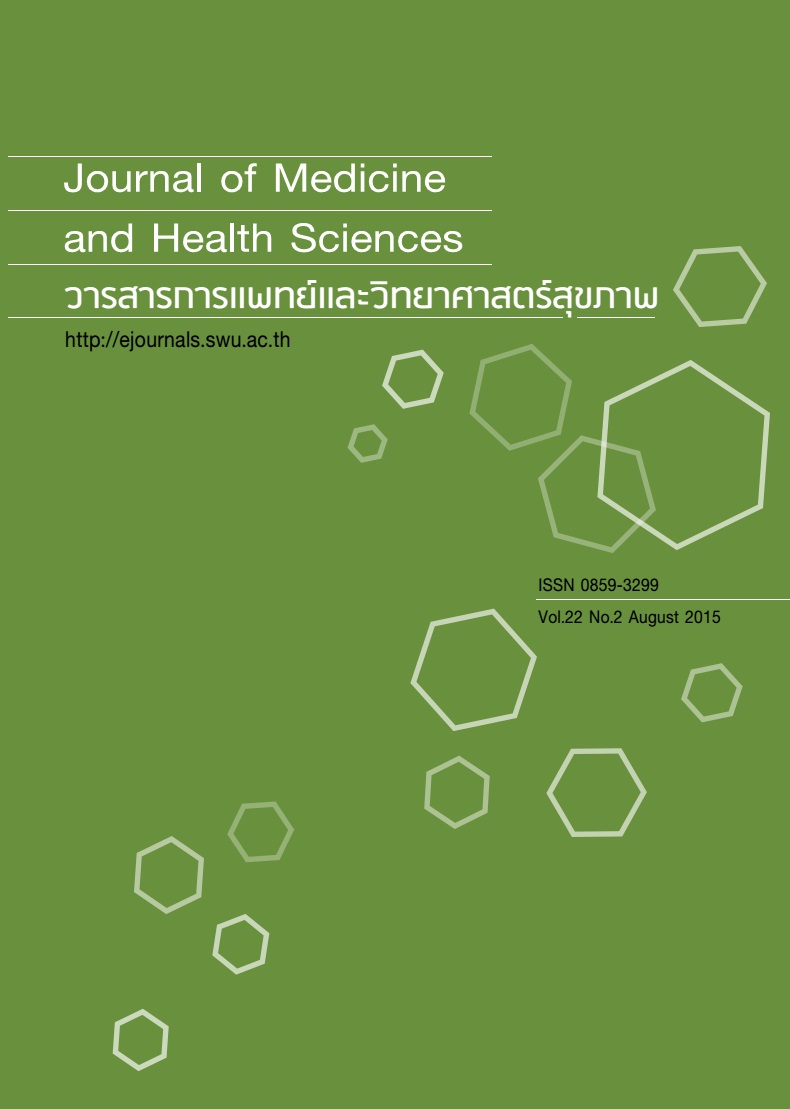Antimicrobial activity of nisin on common dermatological pathogens
Keywords:
ไนซิน, โรคติดเชื้อทางผิวหนัง, ต้านจุลชีพก่อโรคทางผิวหนัง, จุลชีพก่อโรคทางผิวหนังที่พบบ่อย, Nisin, Dermatological diseases, Anti-microbial activity, Common dermatologicalAbstract
Environmental changes and lack of proper medical treatments can induce drug resistant microbes including those from dermatological infections. Therefore, alternative and effective treatments against dermatological pathogens from natural resources and herbs become essential. This study aimed to determine a promising nisin treatment as an alternative way for preventing dermatological infections. Nisin from Lactococcus lactis was used for in vitro treating common dermatological pathogens usually found in tropical regions including Trichophyton rubrum, Candida albicans, and Staphylococcus aureus. The results showed that nisin reduced the growth of S. aureus as indicated by ที่ Minimal Inhibitory Concentration and Minimal Bactericidal Concentration (120 and 1,920 μg/ml, respectively). Moreover, 960 μg/ml of nisin was found to reduce the growth of T. rubrum and C. albicans as indicated by MIC. In addition, this concentration of nisin 120 μg/ml did not exhibit any effect on fibroblast cells in vitro. Therefore, this study demonstrated that nisin can be probably used as an alternative therapeutic agent for treating dermal infection caused by common dermatological pathogens.
ความสามารถของไนซินต่อการยับยั้งจุลชีพก่อโรคทางผิวหนังที่พบบ่อย
การเปลี่ยนแปลงของภูมิอากาศร่วมกับการใช้ยาที่ไม่มีการควบคุมอย่างเหมาะสม โดยเฉพาะกลุ่มยาปฏิชีวนะ ส่งผล ให้เชื้อก่อโรคที่ผิวหนังดื้อยา และอัตราการติดเชื้อดื้อยาในคนไข้เพิ่มมากขึ้น ด้วยเหตุดังกล่าวจึงมีการพัฒนาผลิตภัณฑ์ที่มีผล ในการยับยั้งการเจริญของจุลชีพก่อโรคจากสมุนไพรและผลิตภัณฑ์ธรรมชาติอื่นๆ เพิ่มขึ้น เพื่อนำมาใช้แทนยาและเวชภัณฑ์ ต่างๆการศึกษาวิจัยครั้งนี้มีจุดประสงค์เพื่อศึกษาผลของไนซินซึ่งสร้างจากแบคทีเรียกลุ่มLactococcus lactisต่อการยับยั้ง การเจริญของจุลชีพก่อโรคผิวหนังที่พบบ่อยในภูมิภาคเขตร้อนในสภาพแวดล้อมทดลอง คือ เชื้อรา Trichophyton rubrum ยีสต์ Candida albicans และแบคทีเรีย Staphylococcus aureus จากการศึกษาพบว่าไนซินสามารถลดการเจริญของ เชื้อแบคทีเรีย S. aureus ได้ที่ Minimal Inhibitory Concentration (MIC) และ Minimal Bactericidal Concentration เท่ากับ 120 และ 1,920 µg/ml ตามลำดับ โดยความเข้มข้นของไนซินที่ 120 µg/ml ไม่ส่งผลกระทบต่อเซลล์ไฟโบรบลาสต์ สำหรับการศึกษาในเชื้อราและยีสต์ พบว่าไนซินสามารถลดการเจริญได้น้อยและต้องใช้ปริมาณไนซินสูงที่ค่า MIC เท่ากับ 960 µg/ml จากผลการทดลองนี้เห็นได้ว่าไนซินมีผลต่อการลดการเจริญทั้งของเชื้อแบคทีเรีย เชื้อรา และยีสต์อีกทั้งยัง ไม่ทำลายเซลล์ไฟโบรบลาสต์ที่ความเข้มข้นดังกล่าว ดังนั้น จึงสรุปได้ว่าไนซินเป็นสารธรรมชาติที่เหมาะสมจะใช้เป็น ทางเลือกในการยับยั้งการเจริญเติบโตของเชื้อจุลชีพก่อโรคทางผิวหนังที่พบบ่อยในบริเวณพื้นที่เขตร้อน



